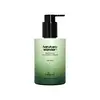What's inside
What's inside
 Key Ingredients
Key Ingredients

No key ingredients
 Benefits
Benefits

 Concerns
Concerns

 Ingredients Side-by-side
Ingredients Side-by-side

Water
Skin ConditioningGlycerin
HumectantHelianthus Annuus Seed Oil
EmollientCaprylic/Capric Triglyceride
MaskingHydrogenated Polyisobutene
EmollientPotassium Cetyl Phosphate
EmulsifyingDiisostearyl Malate
EmollientUrea
BufferingPentaerythrityl Tetraisostearate
Emollient1,2-Hexanediol
Skin ConditioningButylene Glycol
HumectantParfum
MaskingHydroxyacetophenone
AntioxidantStearyl Alcohol
EmollientCetyl Alcohol
EmollientGlyceryl Stearate
EmollientPrunus Amygdalus Dulcis Oil
Skin ConditioningSqualane
EmollientArgania Spinosa Kernel Oil
EmollientAcrylates/C10-30 Alkyl Acrylate Crosspolymer
Emulsion StabilisingXanthan Gum
EmulsifyingCalophyllum Inophyllum Seed Oil
AntimicrobialBambusa Vulgaris Water
Skin ConditioningStearic Acid
CleansingEthylhexylglycerin
Skin ConditioningPalmitic Acid
EmollientPhyllostachys Pubescens Shoot Bark Extract
Skin ConditioningDisodium EDTA
Tromethamine
BufferingPhyllostachys Nigra Leaf Extract
Skin ConditioningAspergillus Ferment
Skin ConditioningMandelic Acid
AntimicrobialMyristyl Alcohol
EmollientArachidic Acid
CleansingLauryl Alcohol
EmollientMyristic Acid
CleansingOleic Acid
EmollientCitronellol
PerfumingGeraniol
PerfumingLimonene
PerfumingCitral
PerfumingLinalool
PerfumingWater, Glycerin, Helianthus Annuus Seed Oil, Caprylic/Capric Triglyceride, Hydrogenated Polyisobutene, Potassium Cetyl Phosphate, Diisostearyl Malate, Urea, Pentaerythrityl Tetraisostearate, 1,2-Hexanediol, Butylene Glycol, Parfum, Hydroxyacetophenone, Stearyl Alcohol, Cetyl Alcohol, Glyceryl Stearate, Prunus Amygdalus Dulcis Oil, Squalane, Argania Spinosa Kernel Oil, Acrylates/C10-30 Alkyl Acrylate Crosspolymer, Xanthan Gum, Calophyllum Inophyllum Seed Oil, Bambusa Vulgaris Water, Stearic Acid, Ethylhexylglycerin, Palmitic Acid, Phyllostachys Pubescens Shoot Bark Extract, Disodium EDTA, Tromethamine, Phyllostachys Nigra Leaf Extract, Aspergillus Ferment, Mandelic Acid, Myristyl Alcohol, Arachidic Acid, Lauryl Alcohol, Myristic Acid, Oleic Acid, Citronellol, Geraniol, Limonene, Citral, Linalool
 Reviews
Reviews

Ingredients Explained
These ingredients are found in both products.
Ingredients higher up in an ingredient list are typically present in a larger amount.
Acrylates/C10-30 Alkyl Acrylate Crosspolymer is a synthetic polymer. It is used to thicken and improve the texture of products. Due to its properties, it can prevent water and oil ingredients from separating.
Butylene Glycol (or BG) is used within cosmetic products for a few different reasons:
Overall, Butylene Glycol is a safe and well-rounded ingredient that works well with other ingredients.
Though this ingredient works well with most skin types, some people with sensitive skin may experience a reaction such as allergic rashes, closed comedones, or itchiness.
Learn more about Butylene GlycolGlycerin is already naturally found in your skin. It helps moisturize and protect your skin.
A study from 2016 found glycerin to be more effective as a humectant than AHAs and hyaluronic acid.
As a humectant, it helps the skin stay hydrated by pulling moisture to your skin. The low molecular weight of glycerin allows it to pull moisture into the deeper layers of your skin.
Hydrated skin improves your skin barrier; Your skin barrier helps protect against irritants and bacteria.
Glycerin has also been found to have antimicrobial and antiviral properties. Due to these properties, glycerin is often used in wound and burn treatments.
In cosmetics, glycerin is usually derived from plants such as soybean or palm. However, it can also be sourced from animals, such as tallow or animal fat.
This ingredient is organic, colorless, odorless, and non-toxic.
Glycerin is the name for this ingredient in American English. British English uses Glycerol/Glycerine.
Learn more about GlycerinParfum is a catch-all term for an ingredient or more that is used to give a scent to products.
Also called "fragrance", this ingredient can be a blend of hundreds of chemicals or plant oils. This means every product with "fragrance" or "parfum" in the ingredients list is a different mixture.
For instance, Habanolide is a proprietary trade name for a specific aroma chemical. When used as a fragrance ingredient in cosmetics, most aroma chemicals fall under the broad labeling category of “FRAGRANCE” or “PARFUM” according to EU and US regulations.
The term 'parfum' or 'fragrance' is not regulated in many countries. In many cases, it is up to the brand to define this term.
For instance, many brands choose to label themselves as "fragrance-free" because they are not using synthetic fragrances. However, their products may still contain ingredients such as essential oils that are considered a fragrance by INCI standards.
One example is Calendula flower extract. Calendula is an essential oil that still imparts a scent or 'fragrance'.
Depending on the blend, the ingredients in the mixture can cause allergies and sensitivities on the skin. Some ingredients that are known EU allergens include linalool and citronellol.
Parfum can also be used to mask or cover an unpleasant scent.
The bottom line is: not all fragrances/parfum/ingredients are created equally. If you are worried about fragrances, we recommend taking a closer look at an ingredient. And of course, we always recommend speaking with a professional.
Learn more about ParfumWater. It's the most common cosmetic ingredient of all. You'll usually see it at the top of ingredient lists, meaning that it makes up the largest part of the product.
So why is it so popular? Water most often acts as a solvent - this means that it helps dissolve other ingredients into the formulation.
You'll also recognize water as that liquid we all need to stay alive. If you see this, drink a glass of water. Stay hydrated!
Learn more about Water